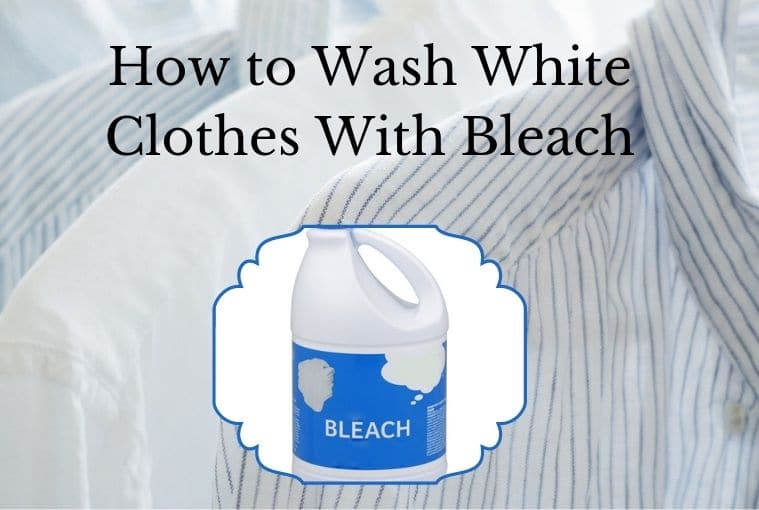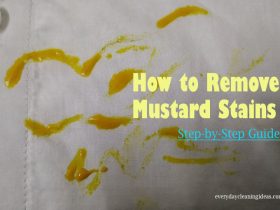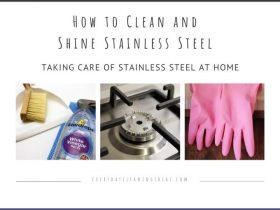As a mother, the toughest task I have is to make white clothes as white as possible.
It’s difficult when your 12-year-old comes home from soccer practice with stains all over the tidy white uniform in which I sent her to school.
But little patience and plenty of elbow grease get the job done every time. Hand washing white clothes with detergent is never enough. You need to use bleach if you are aiming for perfection.
I have spent years making linen and formal shirts look whiter than snow. In the process, I have learned a lot how to wash stained white clothes and make them look as good as new.
Let me share all my secret tips for washing white clothes with you.
What Is Bleach, Anyway?
Any chemical product that is used to remove stains is known as bleach. The most common among the formulations is sodium hypochlorite (NaOCl).
Household bleach contains 3-5% of sodium hypochlorite. Since the chemical, which is a pale greenish-yellow fluid, decomposes quickly in sunlight, a tiny amount of sodium hydroxide (NaOH) is added. This reduces the decomposition of bleach.
Enough chemistry for one day!
Does Bleach Make Clothes White?
Yes. Bleach dissolves the stain, and it washes out.
How does it happen? I cannot tell you much about the molecules and how they interact. Science was never my strongest subject in school.
But with my hand on my heart, I can tell you that liquid bleach is the best way to clean white clothes.
What About Baking Soda?
Yes, that works too. Baking soda is good but not as perfect as bleach. Baking soda is excellent at removing odor and making washed linen smell great.
Types of Bleach
- The primary form of bleach is sodium hypochlorite. We also know it as chlorine bleach. Clorox is an excellent example. It is the most effective form of bleach but requires caution while handling.
- The other form is sodium percarbonate, e.g. OxiClean. It is safe and easy to use and needs no precautions.
Of course, the brand names might differ across the world. But Google wherever you are and a local brand would pop up.
How to Bleach Clothes White?
Now let me teach you the best way to bleach clothes white.
- You need a large bucket, able to hold at least 10 liters (or a little less than three gallons) of water. Make sure that it is sturdy and does not react with chemicals. Otherwise, you could use the bathtub.
- Pour into it 60 ml (two ounces) of bleach. If you don’t have a dispenser, that is about half of a small cup. This is the amount I use. It might be more or less depending on the strength of bleach you have purchased. Please check the label for accurate measure.
- Add 2-3 heaped teaspoons of detergent. Remember that these measurements are approximate.
- You might add a teaspoon of baking soda to the mix as well. But it’s entirely optional.
- Fill three-fourths of the bucket with water.
- Stir and mix the chemicals well.
- Dip the stained white clothes in the mix. Stir with your hands and ensure that it is completely soaked.
- Give at least fifteen minutes. It takes time to dissolve all the grime. You might stir it once in between.
- Remove clothes from chlorine bleach and place them in the washing machine for a regular wash cycle. This would remove any remnants of bleach from your clothes.
- If you don’t use a washing machine, rinse the clothes in running water. Carefully scrub out any remaining stains with detergent.
That’s it. You have learned how to bleach white clothes with stains.
No longer do you have to worry about smudges made by sauce on a white handkerchief or a bed sheet that has turned yellowish with age.
I don’t know if there is any science behind it, but I prefer to dry bleached clothes in bright sunlight. After a couple of hours in the afternoon sun, the clothes look brilliant white.
I have a small backyard where I can dry clothes with no objection from neighbors. Everyone might not be as lucky. In that case, use the drying cycle on the washing machine.
Safety While Using Bleach
Bleach is not something you can experiment with. Remember, first and foremost that it is a corrosive chemical.
What are the safety tips you have to keep in mind? We take a closer look.
Make sure the windows are open and the room has sufficient ventilation. It is not a good idea to use bleach in an air-conditioned environment. Upon decomposition, bleach releases chlorine gas and if it accumulates in the room, you might fall ill.
Always test the bleach solution before you use it. If you are washing a shirt, for example, you can try it on the inside of the collar. This little trial lets you know that the concentration is excessively strong.
Wear gloves when handling bleach. Use rubber gloves that do not interact with chemicals. Never let bleach touch your skin. It will not burn like acid but you might be allergic and have a strong reaction.
Wear a plastic apron to prevent the bleach from smearing your clothes and leaving faded spots.
When rinsing, be careful that bleach solution does not spatter and enter your eyes. If it happens, wash your eyes with cold water for several minutes. Consult a medical professional as soon as possible.
Use bleach meant for laundry purposes, not potent concentrations meant for bathroom cleaning.
We can only use bleach to wash cotton or polyester cotton. Never apply bleach to wool and silk.
Can You Wash Colored and White Clothes Together?
It is not a good idea.
Let me explain why.
Colored clothes are dyed using a variety of different techniques. There are dozens of different types of dyes made from plants, minerals, etc and each has a separate interaction with bleach.
If you would like to wash colored clothes use non-chlorine bleach.
Otherwise, you could experiment with each and find if the garment or linen is colorfast. Colorfast is a measure of fade resistance.
Sodium hypochlorite bleach would make most garments and linen lose color. Why take a risk when you could use a safer alternative.
Should I Wash White Clothes in Hot or Cold Water?
Water temperature should ideally be 120°F or 50°C. This is warm (but not hot) and ensures maximum cleaning.
Cold water (less than body temperature) reduces the efficacy of bleach. Dissolving stains in bleach is a chemical process and happens best at mildly elevated temperatures.
How Often Can You Bleach Your White Clothes
This is an interesting question.
White cloth has no color. Therefore, it cannot fade.
However, there is the question of durability.
Sturdy cotton with a high thread count can withstand monthly treatment with bleach.
More delicate fabric such as white damask linen would not fare well.
That is why restaurant tablecloths are made from thick cotton and poplin. They can take repeated treatment with bleach with no observable change.
Few Words of Advice
I hope you learned all about the use of bleach and the precautions to adopt.
Never mix bleach with any chemical other than detergent and baking soda.
Keep it out of reach of children and pets. It is poisonous if swallowed by mistake.
Dispose of the bleach solution responsibly. Do not let it affect the environment.
Just a few little things and nothing that should cause you undue worry.









Leave a Reply
View Comments